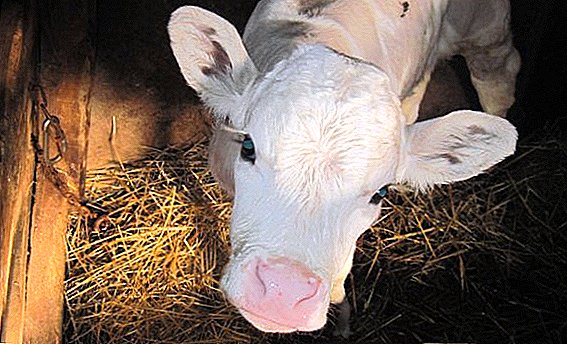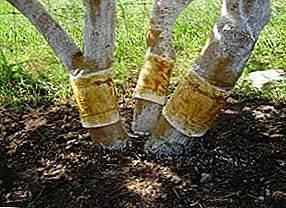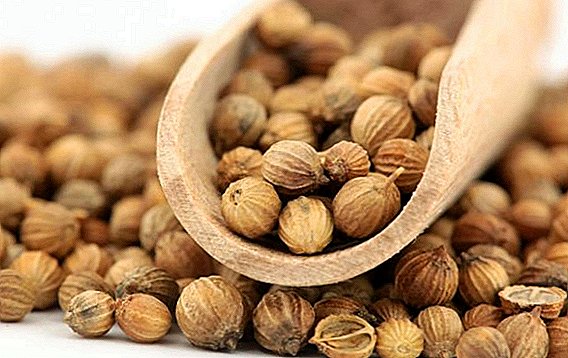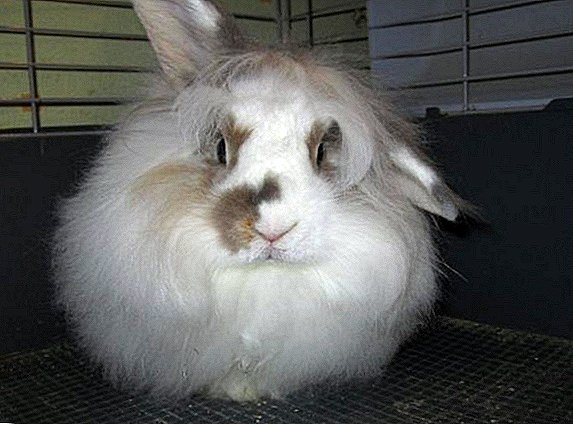 Ears are a great pride and the most visible part of the body of any rabbit. However, even with the right conditions for keeping it, you may find that one or both ears of an animal fell or sagged. Let's look at why this happens, what to do with it and how to prevent it.
Ears are a great pride and the most visible part of the body of any rabbit. However, even with the right conditions for keeping it, you may find that one or both ears of an animal fell or sagged. Let's look at why this happens, what to do with it and how to prevent it.
Causes of rabbits' drooping ears
This can be a variety of reasons. Some of them do not require any intervention, while others, on the contrary, will require a lot of time and effort to correct the situation. 
Hall injury, fracture of the ear cartilage
If only one ear of the animal is hanging, then the cause may be a mechanical impact - injury or bite. Especially often this happens if several individuals live in a small area and begin to show aggression towards each other. Injuries also occur when falling, due to uncleared sharp objects, when trapped by structural elements, mesh cells or feeders. Carrying the pet behind the ears can also cause damage to them, since they are not designed for such heavy loads.
Did you know? Rabbits are a great disaster for the Australian continent, causing damage worth more than $ 600 million a year, threatening the existence of other rare animal species and leading to soil degradation. In many states, keeping them as a pet is prohibited. So, in Queensland it is punishable by a fine of 30 thousand dollars.
Raising the rabbit by the ear, it is very easy to stretch or even damage the auricle and lead to loss of functionality of the organ of hearing. For the treatment of a fracture it is necessary to impose a splint. Pull off this moment is not worth it, otherwise the cartilage can grow together wrong. It should also be noted that the older the rabbit, the longer the healing will be. Fortunately, injuries are much less common with older individuals than with juveniles. As a tire, it is good to use a piece of three-ply corrugated packaging cardboard.
The tire should be with rounded edges, so as not to injure the animal, at least 5 cm long and completely overlap the breaking line in width. To attach the splint to the ear, a double-sided patch is used. Not earlier than 14 days after the tire is applied, the process of splicing can be checked. Given the nature of the injury and the individual characteristics of the individual, it may take a month or even more to complete healing.  To speed up the process of restoring cartilage, you can use special preparations for the growth and fusion of cartilage tissues (chondroprotectors). Some breeders stick their injured ear to a healthy one using adhesive tape to fix the room. Thus, vertical fixation facilitates the process of cartilage repair.
To speed up the process of restoring cartilage, you can use special preparations for the growth and fusion of cartilage tissues (chondroprotectors). Some breeders stick their injured ear to a healthy one using adhesive tape to fix the room. Thus, vertical fixation facilitates the process of cartilage repair.
Presence of a foreign body
An object in the ear canal can negatively affect the nervous and circulatory systems of an animal and lead to lowering of the ear. The sign of a foreign object in the animal's ear is that it constantly shakes its ears, turns its head and tilts it to the affected side. The rabbit becomes restless and loses its appetite.
Important! Carrying the rabbit by the ears is especially dangerous for large and weighty individuals. With such an uplift, the downward movement of the diaphragm occurs, and the animal may suffocate or tear its heart.
If possible, you should carefully, using tweezers with rounded ends, to get a foreign body, but if it is too deep, it is better to consult a specialist. And for the future, you should periodically inspect the pet's ears in order to notice the problem in time.
Too hot
Rabbit ears are very sensitive to temperature changes and are the first to respond to these changes. Animals especially suffer from prolonged, hot weather, when the temperature is above +25 ° C. It literally exhausts rabbits, manifesting itself as a lack of appetite, lethargy and loss of tone. As a result, the blood flow in their ears increases in an attempt to cope with the function of heat transfer, and since the cartilage system of young individuals is still underdeveloped, this leads to lowering of the ears.  Worry about this is not worth it, because this process is reversible, and as soon as the air temperature drops, the ears will again occupy a standing position. However, to help, it is necessary to fight the heat and overheating of the cells with animals in all possible ways. It is also good to supplement the diet of rabbits with additional vitamins, micro and macro elements.
Worry about this is not worth it, because this process is reversible, and as soon as the air temperature drops, the ears will again occupy a standing position. However, to help, it is necessary to fight the heat and overheating of the cells with animals in all possible ways. It is also good to supplement the diet of rabbits with additional vitamins, micro and macro elements.
It should be noted that prolonged exposure to temperatures above +50 ° C on cartilage tissue leads to destructive and irreversible processes. In addition to falling ears, the animal can earn a strong heat stroke, so this should not be allowed, especially for a long period.
Learn how to treat rabbit sores
Frostbite ears
Another reason for the fall of the rabbit's ears may be an unheated aviary or a long stay in the cold. As a result of frostbite, the animal becomes sluggish, the skin under the coat turns pale and the ears go down. In order to prevent this, it is necessary to arrange warmed rooms for the wintering of rabbits, and in case of frostbite, lubricate the affected areas with goose or pork fat.  With a strong frostbite, a treatment with 1% camphor ointment helps well. At the same time it is necessary to lubricate only dried places. Another good healing drug is Aluspray aerosol. It is applied to the affected area after preliminary sanitization - removal of wool and dead skin.
With a strong frostbite, a treatment with 1% camphor ointment helps well. At the same time it is necessary to lubricate only dried places. Another good healing drug is Aluspray aerosol. It is applied to the affected area after preliminary sanitization - removal of wool and dead skin.
Important! It is impossible to treat the wounds on the ears of the animal with alcohol, including iodine and green, because this can cause a burn to the delicate skin of the rabbit.
Subcutaneous mite or lice
One of the common causes of falling ears of rabbits are parasites - ticks and lice. The bites of a scabies mite, which settled in the subcutaneous layers, lead to the fact that the rabbit begins to comb the affected areas. The pet weakens from constant brushing, begins to refuse food, which leads to a lack of necessary trace elements in the body and lowering of the ears. With a strong defeat, the causative agent of the disease can capture almost the entire surface of the body, causing general body intoxication, edema, inflammation and even anemia.  Treatment of the disease should be carried out only under the supervision of a veterinarian. For minor lesions, special aerosols and shampoos are used. You may need to treat the entire surface of infection with acaricidal drugs. When festering wounds appear, antibiotics are usually prescribed. For the destruction of all ticks should be treated with insecticide cage and room for rabbits. A similar situation is observed when lice appear in animals.
Treatment of the disease should be carried out only under the supervision of a veterinarian. For minor lesions, special aerosols and shampoos are used. You may need to treat the entire surface of infection with acaricidal drugs. When festering wounds appear, antibiotics are usually prescribed. For the destruction of all ticks should be treated with insecticide cage and room for rabbits. A similar situation is observed when lice appear in animals.
In the place of their bites appear red dots and small swelling, which the rabbit begins to comb. To get rid of lice apply 3-5% dust chlorophos, 2% dust sevin. Cells are cleaned and watered with hot ash lye or just boiling water. As a preventive measure, it is necessary to observe hygiene in the cells and periodically inspect eagles for the presence of parasites. New animals should be thoroughly inspected and quarantined.
Learn how to treat a rabbit tick.
Malnutrition
Not getting good nutrition with the necessary set of vitamins and trace elements, rabbit ears can fall. The fact is that the cartilaginous tissue of the ears of babies is still thin and soft and only with age gets the necessary density. In addition, the ear must have elasticity and elasticity, which is determined by the normal development and tone of the cartilage body fibers.  In the case of lack of the necessary building material - collagen and elastin - the thickness of the cartilage does not keep up with the size of the ears. And then they do not maintain their own weight and begin to sag. To prevent this from happening, the rabbit's diet should be monitored for the presence of all the necessary vitamins, micro and macro elements. The proper development of cartilage depends on zinc, selenium, iodine, chromium and nicotinoamide (vitamin PP).
In the case of lack of the necessary building material - collagen and elastin - the thickness of the cartilage does not keep up with the size of the ears. And then they do not maintain their own weight and begin to sag. To prevent this from happening, the rabbit's diet should be monitored for the presence of all the necessary vitamins, micro and macro elements. The proper development of cartilage depends on zinc, selenium, iodine, chromium and nicotinoamide (vitamin PP).
In industrial feed information on the composition is always indicated on the label. When preparing the diet yourself, it is better to use the reference books and check whether these elements are present in the products that you give to the rabbit. They are, for example, rich in bone and bone and bone meal. And vitamin PP is found in buckwheat, corn, potatoes, beets and watermelon pulp.
Did you know? The world's largest rabbit is a five-year-old female named Amy from the English city of Worcester. Her weight is almost 19 kg, and the length is about 1.2 m. Amy is so massive that the hostess could not pick up her cage in size and the bunny was forced to live in a dog kennel.If the problem with the ears arose unexpectedly against the background of a long reception of the same food, then perhaps this is due to a decrease in the immunity of the animal. In this case, you can use special dietary supplements (BAA) on a plant-based, for example, the complex vitamin immunomodulator Gamavit.
Growth too fast
Today, fast-growing hybrid varieties are becoming increasingly popular among rabbit breeders. In such a short period of time, animals need to form many important organs and systems — the heart, vessels, lungs, liver, bones, joints, and others.  As a result, some "minor" parts of the body may suffer. Thus, the growth rate of the ear begins to outpace the rate of formation of the cartilaginous framework, and the ear falls. For such individuals it is necessary to make a diet with the use of vitamin supplements and supplements in the form of premixes.
As a result, some "minor" parts of the body may suffer. Thus, the growth rate of the ear begins to outpace the rate of formation of the cartilaginous framework, and the ear falls. For such individuals it is necessary to make a diet with the use of vitamin supplements and supplements in the form of premixes.
Period of molting
During intensive molting without adjusting the diet, the rabbit's fur climbs literally in shreds. And for the emergence of new hairs need the same enzymes, macro - and micronutrients, as for the formation of the cartilage base of the ears. Since the animal's body primarily takes care of the coat, cartilage feeding becomes minimal and the destruction of the formed cartilage is manifested.  As a result, bunny ears fall. In this case, you can not take any additional measures, because at the end of the molting ears should restore their position. However, the introduction of an additional vitamin-mineral complex in the diet will speed up this process.
As a result, bunny ears fall. In this case, you can not take any additional measures, because at the end of the molting ears should restore their position. However, the introduction of an additional vitamin-mineral complex in the diet will speed up this process.
The presence of lop-eared rabbit genes
It often happens that under external favorable conditions and the complete health of the animal, the tricot-eared rabbit gradually turns into a fold. The point, it turns out, is in the genes. It is difficult to insure against this, especially if you buy pets from private breeders, and not in large nurseries. Moreover, it may turn out that the lop-eared ancestor was not even a parent, but passed on his genes through a generation.
Important! To enhance the blood circulation of cartilage tissue and accelerate the lifting of the ears, you can periodically massage them. This procedure should be carried out with moderate pressure, stroking the ears from the bottom up and gently letting go at the top. Usually the massage is carried out by decorative rabbits and they like it a lot.
To avoid such a situation, you should take rabbits from trusted breeders, and it is better to buy decorative animals from the pedigree. In general, the risk always remains, and you can only rely on your good luck and the integrity of the sellers. If your pet had lop-eared ancestors, you will have to put up with it, since it is impossible to correct the position of his ears. Usually this does not appear immediately, but only as the rabbits grow, their ears become heavier and sag. In this case, one ear sometimes continues to stand upright. 
Basic rules for rabbit care
For the proper development of rabbits, you must follow some rules:
- organize a clean, spacious and well ventilated room without drafts;
- to provide a spacious cage with a pallet, tray and bedding - with straw or sawdust;
- daily change the litter, wash the tray and tray;
- once a week, thoroughly wash and disinfect the whole cell with a weak solution of potassium permanganate;
- provide a full and balanced diet;
- every day to remove the remnants of food from the bowl, rinse the water bowl;
- instill against myxomatosis, viral hemorrhagic disease and, in the case of walking outside, from rabies;
- regularly comb the wool, cut the claws with a clipper or special tweezers;
- arrange a new quarantine for the new rabbits and immediately remove the diseased individuals.












